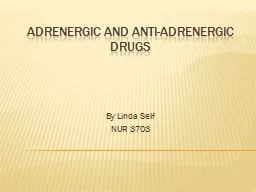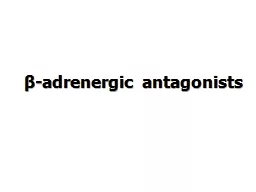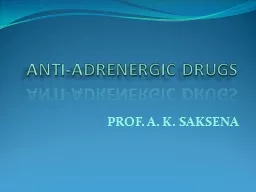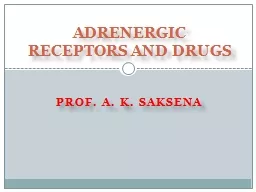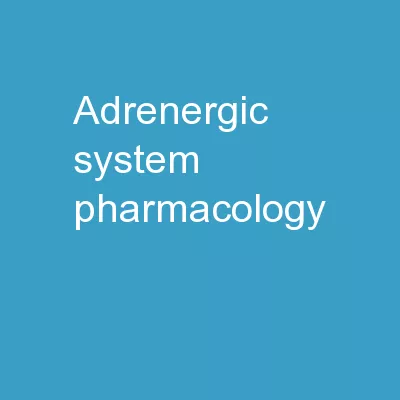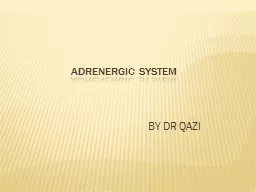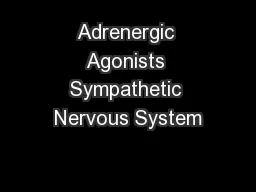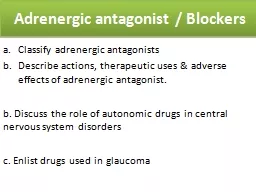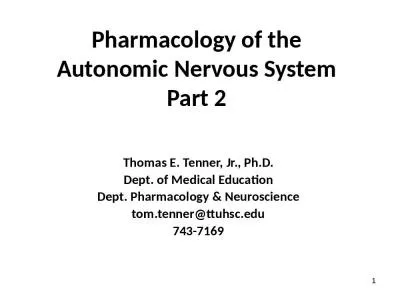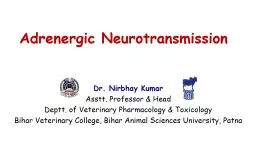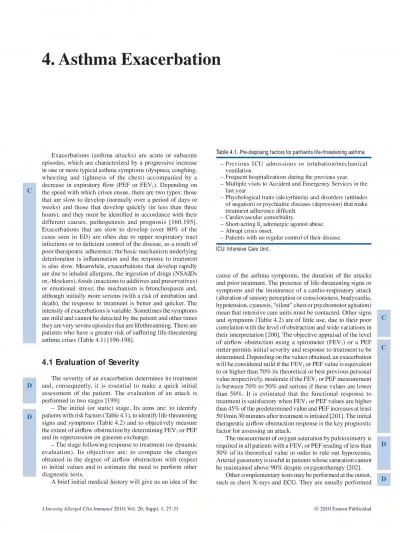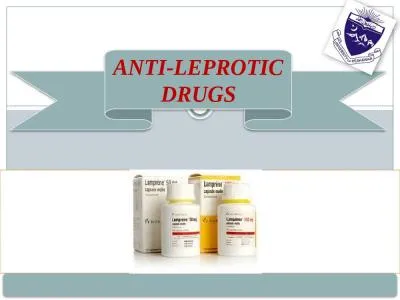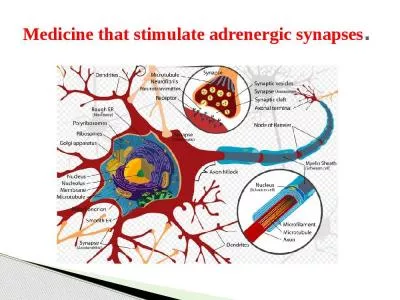PPT-Adrenergic and anti-adrenergic drugs
Author : trish-goza | Published Date : 2019-01-31
By Linda Self NUR 3703 Divisions of human nervous system Nervous system Sympathomimetic or adrenergic in sympathetic nervous systemneurotransmitters are Parasympathomimetic
Presentation Embed Code
Download Presentation
Download Presentation The PPT/PDF document "Adrenergic and anti-adrenergic drugs" is the property of its rightful owner. Permission is granted to download and print the materials on this website for personal, non-commercial use only, and to display it on your personal computer provided you do not modify the materials and that you retain all copyright notices contained in the materials. By downloading content from our website, you accept the terms of this agreement.
Adrenergic and anti-adrenergic drugs: Transcript
By Linda Self NUR 3703 Divisions of human nervous system Nervous system Sympathomimetic or adrenergic in sympathetic nervous systemneurotransmitters are Parasympathomimetic or cholinergic are used to describe parasympathetic systemneurotransmitter is . Chapter 13, . Stryer. Short Course. Signal Transduction. Signal from exterior of cell must affect interior of cell. Through the membrane. Amplification of signal. Ability to turn off. A few pathways…. β-adrenergic antagonists are commonly used to treat hypertension, angina, tremor, migraine, and panic attacks.. ACTION. β-adrenergic antagonists competitively antagonize the effects . of . catecholamines. α. ADRENOCEPTOR ANTAGONISTS. Phenoxybenzamine. ,. Phentolamine. , . Tolazoline. , Ergotamine. , DHE, . Ergotoxine. Yohimbine. (. α. 2. ). Non-selective older drugs; Block both . α. 1. & . α. ADRENERGIC RECEPTORS. . . α. 1. . α. 2. -Postsynaptic . Presyn. . (periphery). - Sm. M of peripheral B.V. - ↓ NT release . DR. ISHOLA I.O.. DEPT OF PHARMACOLOGY, THERAPEUTICS AND TOXICOLOGY. CMUL. ADRENERGIC TRANSMISSION. Adrenergic transmission is restricted to the sympathetic nervous system. Norepinephrine. is the transmitter at post-ganglionic sympathetic nerves – except sweat glands . OBJECTIVES. 1. Know anatomical organization of ANS.. 2. Discuss the synthesis, storage, release,. actions and degradation of . adrenergic . 3. Explain . adrenergic. transmission. 4. Discuss . Adrenalin, Noradrenalin. Sympathomimetics (direct & indirect). Sympatholytics. Adrenergic Receptors. Removal of Norepinephrine. Diffuse out of the synaptic cleft. Metabolized by COMT. Reuptake into the neuron. Classify adrenergic antagonists . Describe actions, therapeutic uses & adverse effects of adrenergic antagonist.. b. Discuss the role of autonomic drugs in central nervous system disorders. c. Enlist drugs used in glaucoma. Nervous System. Part 2. . Thomas E. Tenner, Jr., Ph.D.. Dept. of Medical Education. Dept. Pharmacology & Neuroscience. tom.tenner@ttuhsc.edu. 743-7169. 1. Recommended Background Reading :. . Chapters 7, 8, 9, and 10 . Paige Lipski. Overview of coagulation. In health components of coagulation all present in circulation and only become activated when injury occurs. Injury results in:. -vasoconstriction to reduce blood loss and assist platelet adhesion. ). Dr.. . Nirbhay. Kumar. Asstt. . Professor & Head. Deptt. . of Veterinary Pharmacology & Toxicology. Bihar Veterinary College, Bihar Animal Sciences University, Patna. These are drugs which mimic the effects of sympathetic stimulation or those of . ICU: Intensive Care Unit. J Investig Allergol Clin Immunol 2010; Vol. 20, Suppl. 1: 27-31 adrenergic agonists; b) the patient was already requiring oral glucocorticoids. The daily dose is 0.5 to 1 mg INTRODUCTION. Leprosy is a chronic infectious disease caused by . Mycobacterium . leprae. . . OR. Leprosy . is a chronic, communicable disease spread by prolonged, intimate contact with an infected person. .. Adrenomimetics. - it is drugs that imitate the action of . noradrenaline. (NA) in the adrenergic synapses and cause the sympathetic effects on internal organs.. Thus, the main "target" action agonists is adrenergic synapse, which has certain structural and functional features..
Download Document
Here is the link to download the presentation.
"Adrenergic and anti-adrenergic drugs"The content belongs to its owner. You may download and print it for personal use, without modification, and keep all copyright notices. By downloading, you agree to these terms.
Related Documents

